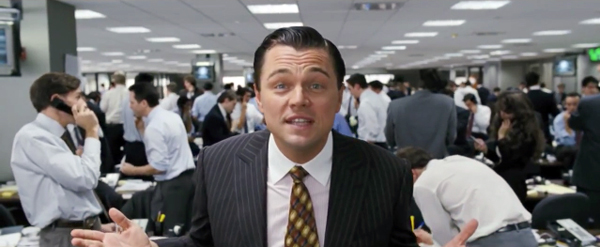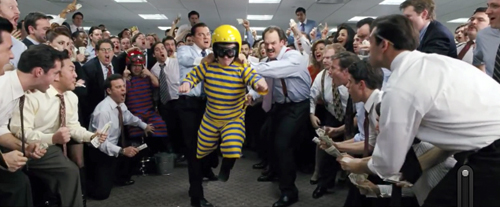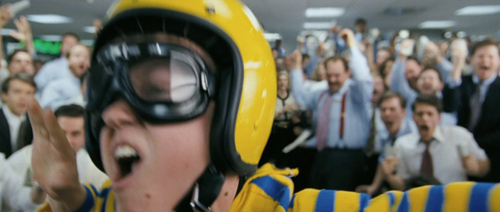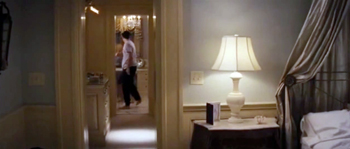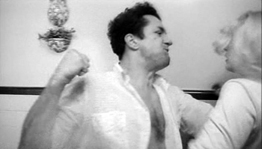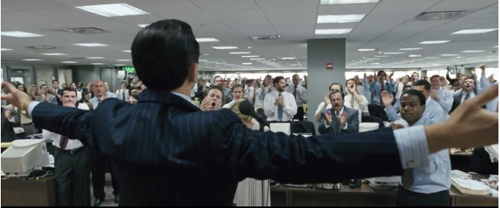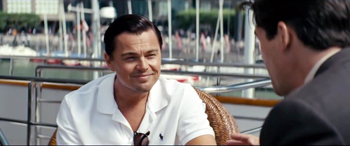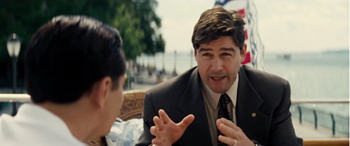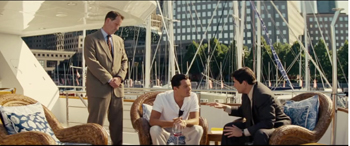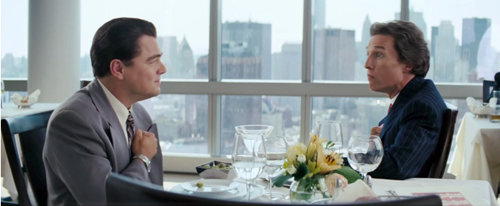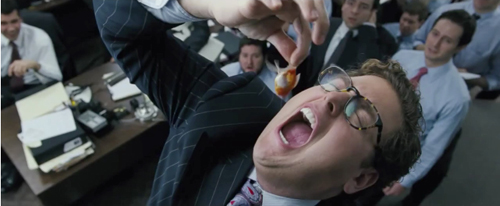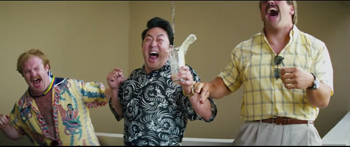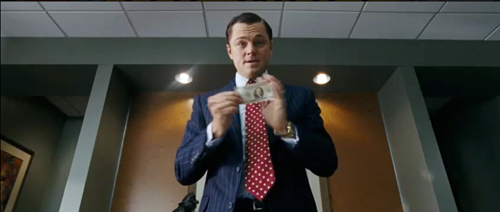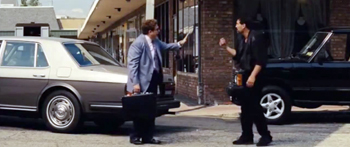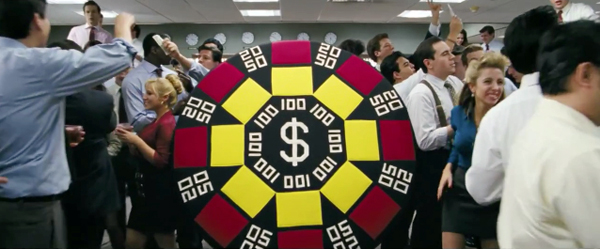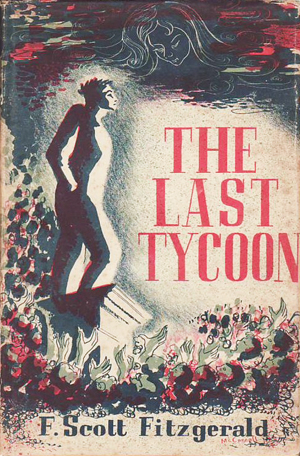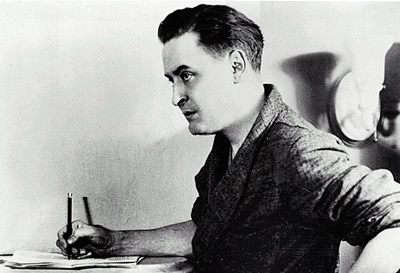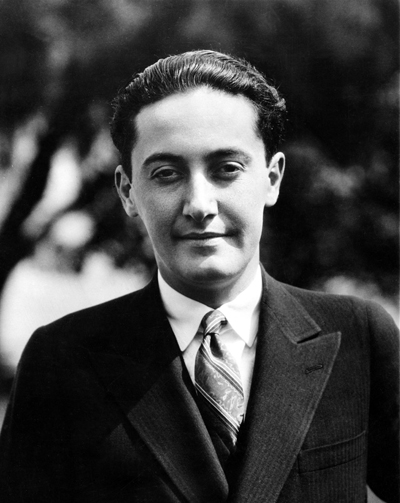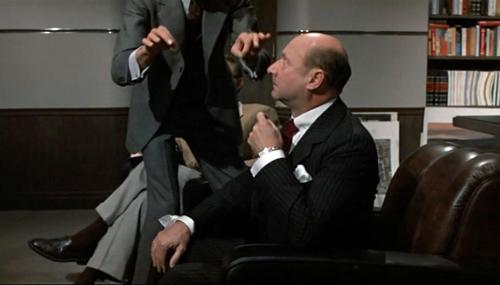Archive for January 2014
Understanding film narrative: The trailer
The Wolf of Wall Street.
DB here:
At many points in The Wolf of Wall Street, we hear the voice of Jordan Belfort chronicling his exploits in building up a rapacious investment company. A few times he even addresses the camera.
What’s he doing? Well, he’s telling us a story, obviously. Stories are what many (not all) films present to us. But how, exactly, can we understand the storytelling process in film? What do the filmmakers do, and what do we do?
For my book Poetics of Cinema, I wrote a chapter called “Three Dimensions of Film Narrative.” This 2007 essay tries to come to grips with several questions. Some are pretty general. What makes a film a narrative? How does a narrative film shape our response? What roles do visual and auditory techniques play? What are the roles of emotional responses and broad cultural factors? How does characterization work in a movie?
Other questions are narrower. How revelatory is Hollywood’s three-act model of plot? How do we pick out a story’s protagonist? Do literary concepts like “narrator” and “implied author” apply to films?
Since the chapter is part of a larger book, some of these matters are dealt with at greater length in other chapters. Some are developed in other books, notably Narration in the Fiction Film, and elsewhere on this site. This essay was my attempt to boil down my thinking about filmic storytelling into one convenient, if sometimes sketchy, form.
Today I’m posting a corrected, slightly revised version of that chapter as a downloadable pdf file. Thanks to our web tsarina Meg Hamel, it has links as well. Students, teachers, researchers, and casual or ardent cinephiles: Make use of this as you like.
The essay is here.
This blog entry is a guide to the essay, or maybe just a trailer. As with a trailer, my use of The Wolf of Wall Street is illustrative; I’m not offering anything like a full analysis or even a review. And like most trailers, mine has spoilers.
The three dimensions I explore in the essay are narration, plot structure, and story world.
Dimension 1: Pushy narration
A film’s narration I take to be unfolding and organization of story information as the viewer encounters it, moment by moment. . (This is distinct from the term “voice-over narration,” like Jordan’s in The Wolf of Wall Street, though voice-over commentary is part of the overall narration.) Narration is designed to shape our itinerary through the film. It’s a complex array of cues that guide us in building up the story.
In The Wolf of Wall Street, the first dose of information we get is a TV commercial for the Stratton Oakmont investment company. We see busy, efficient brokers bent over their desks in a vast office as a lion paces the aisles. But then we get another view of the office, as partying staff prepare to launch a little man in a Velcro suit toward a target. The man is hurled, and one of the men who tosses him identifies himself as Jordan Belfort. We’re then launched into a sequence laying out Jordan’s lifestyle.
One thing this portion of the narration does is to peel back the staid, solid image of the brokering house and show the orgiastic self-indulgence behind it. What if Scorsese and his screenwriter Terrence Winter hadn’t included the commercial? Our sense of the contrast between public image and internal debauchery wouldn’t be so strong.
The quick scenes of Jordan’s lifestyle, driven by drugs, sex, and high living constitute a block of concentrated exposition. The narration could have introduced Jordan’s debauchery gradually through hints, but instead we’re told of it bluntly and swiftly. Jordan boasts that at age 26 he made nearly fifty million dollars a year. We’re coaxed to ask: How did he get so far?
This is, we might say, a curiosity question—a question about what in the past led up to the present. A film’s narration is often prodding us to ask just this question. A piece of narration may also provoke effects of surprise, as when the Velcro-target episode undercuts the corporate image. Surprise is central to narrative because knowledge is distributed unequally among characters and spectators; any character may have a secret.
There’s also suspense, which we can consider broadly as a sharpened anticipation of what might happen next. In The Wolf, I’d argue that there’s some suspense when Jordan, zonked on Quaaludes, must save Donnie from choking on a piece of ham. Curiosity, surprise, and suspense aren’t of course the only effects of storytelling, but they function as “master-effects,” in Meir Sternberg’s phrase. They are central to our comprehension of the story.
Style as narration
At the same time, narration is shaping our experience through film style. The staid tracking shot along the desks in the commercial, with the firm’s trademark lion prowling the aisles, clashes with the abrupt editing and freeze-frame that introduces Jordan. The actors’ performances, centrally the swaggering performance of DiCaprio, are part of narration as well. The soundtrack’s stylistic texture contributes a lot too, with Jordan’s voice-over and the music and effects creating a rousing, exhilarating effect. The narration’s use of film technique, I think, aims to summon up a shocked but fascinated and amused awareness of the decadent world that Jordan rules.
Throughout Wolf, Scorese’s stylistic choices serve narrational purposes. There are rapid montage sequences, commenting musical tunes, and dialogue hooks (“I won’t call him”/shot of Denham, called, approaching Jordan’s yacht). Scorsese’s fondness for rendering psychological states—here, druggy ones—is presented through classic “impressionist” techniques. As the film goes on, he starts to take us into characters’ minds through inner monologues and misperceptions (the smashed Ferarri). Stylistic patterning also contributes to the film’s tone of grotesque comedy, not just through the dialogue, delivery, and music but through editing. The potentially dramatic moment of Jordan rescuing Donnie with CPR is intercut with a Popeye cartoon: Jordan’s miraculous spinach is coke.
By shaping our knowledge, the narration also throttles the film’s emotional appeal up or down. For example, in one scene Jordan punches his second wife Naomi. Scorsese presents the action in a distant shot, in which a doorway allows us merely to glimpse the violence.
This choice lessens the impact of Jordan’s aggression. It gives us important information about the story action, but not nearly as forcefully as the tight close-ups of sexual and drug-fueled escapades in other scenes do. You could argue that closer and more visceral views (of the sort we get during Raging Bull’s domestic violence, as above) would make it harder to treat Jordan’s bad-boy high-jinks as entertaining.
A more detailed analysis would trace the overall development of the film’s narration. We’d consider, for instance, how it restricts our information at key points. Although the narration breaks with its attachment to Jordan to show Denham’s investigation, it doesn’t reveal Naomi’s scheme to divorce him. We learn of that only when he does. As we indicate in Film Art: An Introduction, “Who knows what when?” is a central question for understanding film narration.
Narration as inference-making
More generally, the essay develops in some detail a notion that’s central to understanding narration. I offer a mentalistic account of narrative understanding.
I think that a storytelling movie, through its narration, impels us to draw inferences. To follow a movie story is to turn the images and sounds into characters, actions, events, causes, and the like. This happens partly through fast, automatic inferences of the kind we make constantly in perceiving the world, and partly and more evidently through the inferences we make in building up that construct we call the movie’s story.
Everything I’ve been describing so far asks us to fill in, extrapolate, and draw conclusions at the level of comprehension. We take the Stratton Oakmont commercial as indicating trustworthiness. We’re encouraged to see the little-person-tossing scene as outrageous and boisterous but cruel, the amusement of people charged with a reckless energy. Jordan’s bragging montage sequence invites us see him as powerful, arrogant, and materialistic.
By saying that narration pushes us to make inferences I’m not suggesting that the inferences are models of deep thinking. They are, we say, commonsensical. In the multiplex, we’re not logicians. Understanding and responding to a story are processes based largely on folk psychology. In that respect, the chapter argues a point I’ve made elsewhere on the site.
Of course not all our inferences will be correct. It would be possible to knock down our first impressions of Jordan with information suggesting that beneath the sharkskin is a likable idealist. (That happens in Jerry Maguire.) Here, other sorts of moments steer our inferences astray. We’re led to think that Jordan drives his Lamborghini home safely, but that impression gets recalibrated the next morning. Earlier, when Denham visits Jordan on his yacht, the rather long, tense scene leads us to consider the possibility that the FBI agent is susceptible to bribery. His questions and facial expressions suggest that he’s weighing Jordan’s offer to help him with some investments. This interchange is conveyed in fairly tight shot/ reverse shots.
Only when Denham asks Jordan to repeat his offer does Scorsese cut to an angle showing that Denham’s colleague has, offscreen, quietly stepped close enough to bear witness to the bribe Jordan might offer.
Scorsese has choked off some information about the scene in order to yield a surprise, one that corrects the impression we were building up. One of cinema’s great pleasures is catching up with a narration that has been designed to lead us astray. Hitchcock fans, take note.
Dimension 2: Plot as pattern
You can also think about the narrative as having a more abstract, geometrical structure: that’s given to us as the plot. Narration creates on-line, moment-by-moment pickup; as viewers we go with the flow. The plot is more architectural, a sort of static anatomy of the film as a whole. We can think of it in a couple of ways.
As a map of a particular film, the plot consists of the overall arrangement of incidents. It lays out the story actions in time. It can proceed chronologically, as plots do most of the time, or it can rearrange incidents out of linear order. The Wolf of Wall Street follows the Stratton Oakmont commercial with the Velcro-target scene, and then presents Jordan at the height of his powers. But after the quick exposition of his lifestyle, the plot flashes back to his first day on Wall Street in 1987.
Now the film presents a mostly chronological layout. Jordan gets his broker’s license, loses his job, picks up a low-end one, and then rises to the spot running his company. This trajectory is sometimes interrupted by quick flashbacks filling in background on a character or a situation; we even get flashbacks within flashbacks. The overall time scheme is hazy, since we’re never shown exactly what point in time is “now.” There’s the suggestion that the initial flashback is rounded off when Jordan’s cohorts meet to plan the Velcro-tossing stunt, but that opening scene isn’t replayed, so we can’t be sure exactly when the opening flashback ends. The flashback must be finished at some indeterminate time late in the film, when Jordan’s fortunes decline and Naomi is alienated from him. But the narration whisks us along without establishing the firm framing devices of traditional flashback plotting.
From this perspective, every film establishes its own plot structure, based on the overall “geometry” of its scenes and sequences. There’d be a lot to say about this in The Wolf, such as the introduction of Denham (and the brief alternating scenes of his investigation) and the various lines of action that fill out the plot: Jordan’s addictions, his plan for an IPO, his two marriages, the SEC inquiry, his Swiss money-laundering schemes, and the like. The craft of screenwriting consists in large part of developing and braiding lines of action in this way. Several entries on this site, as well as many chapters of Narration in the Fiction Film and Poetics of Cinema, analyze how such plot patterns work in tandem with the narration’s unfolding.
Caught in the act(s)
Another way to think about plot structure is to consider how the particular film obeys broader principles of construction. Tragedy, comedy, melodrama, mystery stories, and other genres have distinct, widely-known conventions of plot geometry. There are as well traditions of plotting that cross genres.
In modern commercial cinema, the most famous structural convention is the three-act pattern. Kristin has proposed that Hollywood feature filmmaking is better thought of as adhering to a multiple-part principle based on characters’ goals. The film might have two, three, four, or more parts, depending on its running time and the ways it shows character goals created, reformulated, blocked, delayed, and fulfilled (or not). We’ve tested Kristin’s proposal in books (Storytelling in the New Hollywood, The Way Hollywood Tells it) and on this site (here and here and here and here).
The essay considers the matter more theoretically, but just to illustrate, I’ll hazard a layout of The Wolf of Wall Street’s plot structure. It’s nothing but spoilers, so I’ve flagged it all in olive green if you want to skip it.
Since Wolf runs about 173 minutes without credits, I think it can be usefully laid out in five large-scale parts. These are framed by a brief prologue (the commercial and the Velcro-target scene) and an epilogue summing up Jordan’s court sentence, his stay in a country-club prison, and his new career as “the World’s Greatest Sales Trainer.”
The Setup shifts from Jordan’s life at the pinnacle to his beginnings in the business and his rise as an entrepreneur. In the course of this portion he meets Donnie and the two assemble their team of eccentric, grotesque staff. After establishing Stratton Oakmont, Jordan demonstrates his sales technique and the script his salespeople will follow. This section consumes the first thirty-five minutes of the film.
What Kristin calls the Complicating Action, which resets the protagonist’s goals, centers on Jordan’s plan for an IPO and his affair with Naomi. Around the hour mark, Jordan is divorced and free to pursue the IPO, but now Denham of the FBI is following the company and the SEC is getting curious.
The Development section, which typically expands and delays the fulfillment of the goals set earlier, shows Jordan marrying Naomi, the firm’s frenzied launch of the IPO, and Jordan’s botched effort to bribe Denham. By about 96 minutes into the film, the two antagonists, Jordan and Denham, have faced off in a preliminary conflict. What remains is to see how Jordan will evade capture.
I’m inclined to see the fourth part as a second Complicating Action, because Jordan recalibrates his goal. Stratton Oakmont is making so much money he needs to find an offshore place for it. He decides on Switzerland, and the bulk of this section of Wolf focuses on whether he’ll be successful. But the SEC is breathing down his neck, and he momentarily considers quitting his firm. During a pep talk to his staff, his resolve weakens (he’s sold by his own rhetoric), and he decides to fight the regulatory battle. This is a turning point: now both the SEC and the FBI are on his tail with renewed vigor.
This section, a bit longer than the others, runs about forty minutes. I attribute that mostly to a wedged-in scene that’s almost pure delay: Jordan’s and Donnie’s wild night on Quaaludes, which ends with Jordan crawling toward his car, smashing it up, and saving Donnie from choking. Nearly all of this has no effect on the plot’s forward movement; Donnie survives and Jordan isn’t charged for the road mishaps. The only plot causality here is the fact that a wacked-out Donnie makes an incriminating call on Jordan’s home phone, which is tapped. This bit of action could have been handled much more briefly, but the Quaalude gluttony is so inherently funny, and forms such a plausible topper to the ‘lude motif throughout the film, that it’s expanded to a remarkable twelve minutes. This sort of delay is usually seen in Development sections, but because Jordan resets his goals in this section I’m considering it a Complicating Action.
The Climax (25 minutes) arrives when Jordan, hiding in Italy with Donnie and their wives, learns that Aunt Emma, his front for the Swiss money-laundering, has died. He must race back to Zurich to shift the money to a new account, and in the process the yacht is wrecked in a storm. He’s arrested and agrees to rat on his friends. Naomi divorces him. He tries to protect Donnie but fails and is sent to jail. In the epilogue he’s shown bouncing back, playing to an audience of suckers who share his dream of getting very rich.
Winter’s screenplay, with its parallelled and intertwined lines of goal-driven action and its reiteration of one large-scale component, a second Complicating Action, shows how the classical pattern can be expanded to fill out a longer-than-average running time.
Dimension 3: The story and its world
There’s a tendency to think of the story action as existing virtually before it becomes a plot and is presented through narration. It’s as if the story was already there, waiting to be turned into a film. To some extent, this can happen with documentary narratives and adaptations of novels, plays, and comic books. Nonetheless, as viewers we access a movie’s world only through narration and plot structures. In fact, “access” isn’t quite right. As I’ve indicated, I think that we construct the story inferentially, on the basis of the cues given by those other dimensions.
If every viewer has to build up the story herself, shouldn’t we have widely different senses of what happens? To some extent we do. People might fill in certain gaps differently, or draw divergent conclusions about what made something happen. Certain films, not typically Hollywood ones, do encourage more open explorations of the story situations. Here plot construction and narration may follow other conventions, such as those I’ve tried to chart in Narration in the Fiction Film and elsewhere.
Mostly, though, even in “independent films,” there’s a great deal of convergence among viewers’ inference-making. Sooner or later, we arrive at a common understanding of most of what happened and why. As we leave the shared realms of perception and comprehension, of course, viewers’ construals can diverge a lot. Once we get to abstract interpretations—such as whether The Wolf of Wall Street celebrates or condemns the anything-for-a-buck culture—we should expect a lot of variations. (I try to explain why this happens elsewhere in the book, in the essay “Poetics of Cinema.”)
“Three Dimensions of Film Narrative” considers the story and its world broadly, in terms of cues for causation and characterization. It focuses particularly on characters and how we understand them. Again I argue for an inferential model. This means that, as in real life, we’re practicing “mind-reading”—trying to figure out characters’ traits and temperaments on the basis of their behavior, trying to grasp their motives and goals. We build them up as persons on the basis of cues, and we ascribe to them many of the qualities we expect persons in the real world to exhibit. Again, folk psychology provides the ground: the film is likely to streamline and simplify the complexities of real-world personhood.
As viewers we don’t understand a character in isolation. Characters interact, and the narration and plot structure prompt us to compare them, rank them, sort them in different ways. In The Wolf, Jordan is handsome, brazen, and suave; Donnie, a classic weak friend, is awkward and homely, but he has a primal energy that matches Jordan’s slick élan.
Jordan’s father and most of his elders are more prudent and cautious than his crew, who are uninhibited. The guys are a bevy of misfits, distinguished from one another by looks and one or two tricks of demeanor.
Jordan’s first wife is a brunette hair stylist who voices doubts about his schemes; his second wife is a gorgeous blonde party girl who happily plunges into his lifestyle. In each case, the narration and the plot structure give us the necessary cues, usually redundantly. Jordan’s voice-over commentary reinforces the character information we get from the actors’ appearance and performance.
The essay also considers how films present character change. Sometimes characters come to learn more; they may not vary their distinguishing traits but they realize they have made a mistake. More deeply, characters may decide to get in touch with a suppressed side of themselves. That’s what happens, I think, in Jerry Maguire; he becomes the man his wife thinks he could be.
But very often characters don’t change. Jordan, in The Wolf of Wall Street, has an opportunity to confess, return the money he fleeced from his clients, and take his punishment. Instead, he insists that everything he’s done has been for his friends—the staff of the firm—and they deserve to succeed as he has. (Even though he is deceiving them too; he buys shares in his own IPO and orders the salespeople to push that stock.) What shocks many viewers about the film, I suspect, is that Jordan doesn’t become a better person in the course of his adventures. His punishment is light, he learns nothing, and by the end of the film he’s as amoral as he was when he started the company. (“Sell me this pen.”) As sometimes happens, the interest of the plot comes from watching a gifted, resourceful scoundrel adapt his techniques to changing situations.
But wait, there’s more
Okay, you may be asking impatiently. But why? Why offer these categories, carve things up, make supersubtle distinctions, concoct new terminology? Why not just do film criticism?
Well, partly because I want to articulate more than my response to a particular movie. I want to understand the more general ways in which films work and work upon us. I think we can usefully look for explanations of movies’ functions and effects, and these are things that ordinary film criticism doesn’t typically offer. For example, noticing how a film’s elements function with respect to narration, plot, style, and story world can do more than sensitize us to this or that movie. This sort of analysis can make us aware of broad norms of moviemaking and how particular films relate to those norms, currently and historically.
At the same time, the line of thinking I’m proposing casts light on the skills we deploy, mostly unawares, in experiencing films. No matter how simple-minded the movie, I think that we do things in following it; we exercise our narrative competence. On the other side, sorting things out this way can explain the range of choice and control open to the filmmaker. I think that the poetics of cinema I propose can help filmmakers become aware of the tools they are using–and perhaps encourage them to try other ones. My categories are derived from filmmaking craft, and perhaps they can in turn illuminate the practical tasks facing filmmakers.
A couple of final points. In the chapter I draw examples from a variety of films, many American (Cellular, Boyz N the Hood, You’ve Got Mail, etc.). Despite my consideration of Ashes of Time, Claire Dolan, Memento, and other films, some readers will ask why I don’t consider more non-Hollywood examples. The choice was strategic: Hollywood films throw the areas I’m charting into sharp relief. They provide clear-cut (not necessarily simple) examples of my points. And historically, the dominance of Hollywood film in the world’s theatrical market have given them a lot of influence. Much of what we think of as non-Hollywood is based on attempts to revise or reject those norms.
At the same time, I’m counting on readers cutting me some slack because I’ve written a lot about alternatives to Hollywood. My books on Eisenstein, Ozu, Dreyer, and Hong Kong cinema try to analyze diverse storytelling options. Elsewhere in Poetics of Cinema I discuss various narrative traditions, including varieties of network narratives and forking-path plots. Narration in the Fiction Film explores still other storytelling modes. And on this site I’ve had a lot to say about non-Hollywood constructive principles (for example, here and here).
The last section of the essay considers what is probably inside-baseball for many readers. Yet the underlying question is important. How adequately can film narrative can be understood on a model of literary narrative? Some theorists think that the basic principles of narrative are to be found in verbal storytelling, and narratives in other media must find equivalents for them. My own view is that narrative as a phenomenon gets mapped onto different media in varying ways. There may not be a single model that will be valid for plays, novels, dance, comic strips, radio drama, film, digital fiction, and so on.
For example, if Jordan Belfort were a character in a novel, certain weird things wouldn’t be happening onscreen. A first-person narrator in the novel can tell us only things that she or he knows about. But “inside” Jordan’s tale we get all kinds of scenes that he didn’t witness. True, he knew that FBI agent Denham was on his trail, but he couldn’t know the color of Denham’s office, or what Denham said to his colleagues. Nor could Jordan know exactly how the quarrel between his partner Donnie Azoff and his ally Brad Bodnik went down, even though we see the entire scene embedded in “his” telling.
Of course we can say that these scenes are just movie conventions. We accept that in film, first-person voice-over often includes scenes that the speaker didn’t witness, or maybe didn’t even know about. But that convention points to the limits of importing models of storytelling from literature to the study of cinema. A novel can’t wedge those things in without raising the question of how the narrator knows this. We just don’t ask such a question about Jordan.
By a path too winding to summarize here, these and other observations lead me to a counterintuitive conclusion: Narrative, at least in film, isn’t best understood as an act of communication from an author-like entity to a reader-like one. Why do I say that? How can film not be communication? Answer, too brief: What most people call communication I call converging inferences.
And to end my trailer, I suggest that we think of narrative in all media, most especially film, as inherently promiscuous. It will pull in anything that gets the immediate job done. That includes grabbing one element of ordinary conversation–a guy telling a story–without keeping the other bits of the communicative chain, such as feedback from a listener. Jordan is talking to us, but he doesn’t know we’re here, and we can’t interrupt him.
One more time: You can get the essay here. Thanks for reading!
In a way this post is a sequel to the previous entry; background on Meir Sternberg’s account of curiosity, suspense, and surprise can be found there. For more on the subject, see our category “Narrative strategies” and the essay “Common Sense + Film Theory = Common-Sense Film Theory?”
Many of the everyday terms we apply to stories are ambiguous or vague, so sometimes we need to define our terms or invent new ones. Take “narration.” In ordinary talk, can mean “voice-over commentary,” such as Jordan Belfort’s in The Wolf of Wall Street. But if we restrict our usage to just this form of sound, we don’t have a good term for the general flow of narrative presentation in the film, let alone films that don’t have voice-overs. So it’s useful to reserve “narration” for that general process and use “voice-over” in some form to describe the soundtrack’s role in that.
The same problem comes up with the term “point of view,” which has many different meanings. It might refer to first-person reportage, or what a character thinks and feels, or what she believes. (Obama is a good president from her point of view.) If we want to be precise in talking about these qualities of storytelling, we need to explain the terms we’re using.
And sometimes it’s just easier to introduce new terms. In the essay, I’ll sometimes call the plot the syuzhet and the story the fabula. Why the fancy terminology? Won’t “plot” and “story” do? Well, yes, up to a point. In this entry I did use those terms, and our textbook Film Art: An Introduction has done that ever since its first edition of 1979. Still, when we’re working within a research community, it helps to have terms, even unusual ones, which say exactly what we mean. The original readership for the “Three Dimensions” chapter knows that “plot” and “story” have different meanings in our culture, and so I tried to use terms that were less ambiguous. Not incidentally, I wanted as well to signal my debt to the Russian Formalist literary critics, perhaps our first modern narratologists.
Other chapters of Poetics of Cinema are posted online here.
P.S. 14 January 2014: Thanks to Steve Hilby for correcting me: I originally mis-identified Jordan’s car as a Ferrari.
P.S.S. 14 January 2014: My old friend Brian Rose signals his Academy interview with the filmmakers, in which Scorsese and Schoonmaker declare a lack of interest in “plot.” Pfui, says I.
How to tell a movie story: Mr. Stahr will see you now
DB here:
It is 1935. Mr. George Boxley is a prominent writer who has been brought to Hollywood. He is working with two other screenwriters on a story, but he feels angry and dissatisfied. His collaborators ruin his contributions, and when he writes solo he produces “interesting talk but nothing more.” He has come to the head of production to complain, and beneath his annoyance lies a mild contempt for the movie craft.
He has tried to adjust his standards to movies, he explains, by having his dialogue delivered while his characters are dueling. At the end of the scene one falls into a well and has to be hauled up again.
The studio chief, Monroe Stahr, asks if Mr. Boxley would include such a scene in a book of his own.
“Naturally not.”
“You’d consider it too cheap.”
Boxley replies: “Movie standards are different.”
“Do you ever go to them?” Stahr asks.
“No,” confesses the parvenu screenwriter. “Almost never.” He explains, defensively, that movies are full of things like duels and falling down wells “and wearing strained facial expressions and talking incredible and unnatural dialogue.”
“Skip the dialogue for a minute,” said Stahr. “Granted your dialogue is more graceful than what these hacks can write—that’s why we brought you out here. But let’s imagine something that isn’t either bad dialogue or jumping down a well. Has your office got a stove in it that lights with a match?”
“I think it has,” said Boxley stiffly, “—but I never use it.”
Mr. Boxley is about to get a tutorial in how to tell a movie story.
Behind the glitter
F. Scott Fitzgerald
There have been novels about Hollywood as long as the movie industry has been there. Most have been either straightforward wish-fulfillment (girl/boy from the sticks makes it big) or cautionary tales (boy/girl fails or becomes depraved). The more ambitious “Hollywood novel” has been more sour and sweeping. It presents itself as a harsh exposé that makes a broad social comment on picture-makers, their public, and the society that spawns both.
This serious Hollywood novel is largely a creature of the late 1930s. Wedding hard-boiled style to Depression-era realism, Nathanael West’s Day of the Locust (1938) and Horace McCoy’s I Should Have Stayed Home (1938) present stark, aggressively despairing accounts. In these books, Hollywood is America, only more so.
Both West’s and McCoy’s books fared poorly in the market. The triumph was Budd Schulberg’s What Makes Sammy Run? (1941), which found in the rapacious Sammy Glick a prototype of the modern entertainment entrepreneur. Schulberg daringly emphasized the fact that Sammy was a Jew, creating a controversy that lasted for quite a while.
The booming movie market of the war years, along with the fact that more novelists found themselves involved with the studios, made the 1940s something of a golden age of the Hollywood novel. The movie kingdom became the setting for dozens of murder mysteries, veiled memoirs, and satires—some written by practicing screenwriters. (Among the most notable: Ben Hecht’s offhand but heartfelt I Hate Actors!, 1944). At a higher level of literary prestige, there were two 1948 titles from Englishmen, Evelyn Waugh’s caustic The Loved One and Aldous Huxley’s Ape and Essence, a novel written as a pseudo-screenplay. But none of these finished works won the enduring fame of an incomplete story published in the same year that Schulberg introduced Sammy Glick.
Built on the grand scale
Irving Thalberg.
In 1939 F. Scott Fitzgerald had begun The Last Tycoon (perhaps intending to call it The Love of the Last Tycoon: A Western). By then his brief screenwriting career was over, but he was fascinated by MGM’s boy wonder Irving Thalberg, “one of the half-dozen men I have known who were built on the grand scale.” Fitzgerald decided to center his plot on Monroe Stahr, a Thalberg-like producer.
Stahr is a shrewd, intellectually gifted workaholic who is an expert in manipulating what is coming to be a new system of moviemaking. Brisk and efficient in the office, Stahr is occasionally cold and arrogant, but his primary trait is a remarkable sensitivity to the emotional temperature of each situation. He gains our sympathy because in private Stahr is sunk in melancholy, longing for his dead wife and hoping to find another woman to love.
When Fitzgerald died in 1940, he had completed less than half of The Last Tycoon. His long-time friend, the critic Edmund Wilson, assembled an edition that was issued in 1941, with the finished portions supplemented by notes and a five-act outline. The book had a great impact. The New York Times reviewer commented:
Uncompleted though it is, one would be blind indeed not to see that it would have been Fitzgerald’s best novel and a very fine one. Even in this truncated form it not only makes absorbing reading; it is the best piece of creative writing that we have about one phase of American life—Hollywood and the movies.
Matthew J. Bruccoli, who has brought out the authoritative edition, remarks:
Even in its preliminary and incomplete condition, The Love of the Last Tycoon is regarded as the best novel written about the movies.
Reading the book for my research on the 1940s, I became fascinated by its understanding of what we might call the Hollywood aesthetic.
That understanding begins with a recognition of the production process. Most Hollywood novels mention actual stars and directors, but The Last Tycoon goes beyond name-dropping. It takes us into the offices, the editing rooms, and onto the set when Stahr must fire a director. These scenes have an authority that most novels lack, assisted by Fitzgerald’s effort to present his mogul not as a monster but as a man of genuine, if sometimes dictatorial, charm, tact, and taste.
Setting his novel in 1935, Fitzgerald also registers how studio organization shifted toward a central-producer system. Stahr deliberately avoids learning the details of camerawork, editing, and sound.
He could have understood easily enough—often he preferred not to, to preserve a sensual acceptance when he saw the scene unfold in the rushes. . . . His function was different from that of Griffith in the early days, who had been all things to every finished frame of film.
One of Fitzgerald’s most cryptic notes indicates his recognition of different studio styles.
The Warner Brothers narrative writing and the Metro dramatic, packed—cut back and forth writing from Stahr.
This might be a reference to Warners’ vivacious montage sequences, which were sometimes considered “narrative,” while fully enacted scenes were called “dramatic.” The use of “cut back and forth” here exemplifies Fitzgerald’s occasional use of movie slang in his notes, as when he gets his characters on the Super Chief passenger train:
In a very short transition or montage, I bring the whole party West on the chief.
Like many intellectuals of his time, Fitzgerald was fascinated by the movies as an artistic medium. The standard version of film history was articulated in many books of the period, most notably Lewis Jacobs’ Rise of the American Film (1938). Fitzgerald dots his novel with commonplaces about the history of cinema.
She was reputed to have been on the set the day Griffith invented the close-up!
[Stahr] prepared for the meeting [with the Writers Guild] by running off the Russian Revolutionary Films that he had in his film library at home. He also ran off “Doctor Caligari” and Salvador Dali’s “Un Chien Andalou,” possibly suspecting that they had a bearing on the matter.
Astonishingly, Fitzgerald even considered calling his novel The Lumière Man.
Most original, I think, is the episode I’ve started to present to you. It’s an exemplary scene, showing how good Stahr is at his job. He subtly steers Mr. Boxley, the East Coast littérateur, toward returning to the screenplay. But he also tutors Mr. Boxley, and us, in a deeper awareness of how classical Hollywood aimed to tell its stories.
Just making pictures
Imagine, Stahr tells Boxley, you’re sitting in your office, tired out.
A pretty stenographer that you’ve seen before comes into the room and you watch her—idly. She doesn’t see you although you’re very close to her. She takes off her gloves, opens her purse, and dumps it out on the table.
Stahr continues. From her change, the young woman picks out a nickel and puts it on the desk. She picks up a matchbox and then takes her black gloves to the stove. She puts them inside the stove and starts to light it, when the phone suddenly rings.
The girl picks it up, says hello—listens—and says deliberately into the phone, “I’ve never owned a pair of black gloves in my life.”
The stenographer hangs up and kneels by the stove again.
Just as she lights the match you glance around very suddenly and see that there’s another man in the office, watching every move the girl makes.
Stahr pauses.
“Go on,” said Boxley smiling. “What happens?”
“I don’t know,” said Stahr. “I was just making pictures.”
Boxley feels he’s been wrong-footed.
“It’s just melodrama,” he said.
“Not necessarily,” said Stahr. “In any case nobody has moved violently or talked cheap dialogue or had any facial expression at all. There was only one bad line, and a writer like you could improve it. But you were interested.”
Question time
Throughout the 1930s, critics like Otis Ferguson praised American studio pictures for their clean, straight storytelling. The primary concern of Fritz Lang, for instance, “is with the rightness and immediacy of each fragment as it appears to you, makes its impression, leads you along with each incident of the story, and projects the imagination beyond into things to come.” I think that Stahr’s tutorial helps us understand how that blend of immediacy and flow, vivid moments and keen anticipation, works.
For one thing, the gloves scene doesn’t fit certain clichés about Hollywood. It isn’t spectacular; it’s not a chase or a fight or a seduction or a slapstick episode. As Stahr points out, nobody is dueling or falling down a well.
We often say that Hollywood movies emphasize plot (lots of action) over character (stereotyped, at that). But this scene doesn’t have much action, and we don’t know anything about the character. (We can’t even be sure she’s lying; maybe these gloves aren’t hers.) What we have is plot and character fused in a situation. The scene creates, out of mundane materials, a crisis.
We say that Hollywood films grab us through emotion. Do we feel strong passions here? Well, not so much. We say that Hollywood films make us identify with the characters. Are we identifying with the young woman, or the magically unseen Boxley, or the man suddenly revealed watching the whole thing? Not really. The paramount emotion, as Stahr points out, is that diffuse, low-level one we call interest.
What does grab us, I think you’ll agree, are the questions that are implicit in the action. Why does the woman leave a nickel on the desk? Why does she start to burn the gloves? Why does she deny owning black gloves? Why is the man watching her? And what will happen next?
Noël Carroll has developed a theory of narrative he calls “erotetic.” Telling a story, he suggests, creates a controlled cascade of questions. Sometimes they pile up, as here; sometimes a question is answered but the answer raises another question. Stahr’s lesson supports Carroll’s idea that in any art, narration is a matter of asking, postponing, and answering questions. Erotetic principles, Stahr suggests, are more central to Hollywood storytelling than obvious appeals like spectacle and gags.
Another narrative theorist, Meir Sternberg, has proposed that the “master effects” aroused by stories are curiosity, surprise, and suspense. Curiosity is a matter of wondering about what led up to the actions we’re seeing now. What has impelled our stenographer to burn these gloves? Surprise comes from revealing a gap in the telling’s continuity. This occurs when Stahr’s “pan shot” (“you glance around very suddenly”) reveals a man in the office watching her efforts. If curiosity involves the past, and surprise punctuates the present, suspense points us forward: What will happen next? Stahr’s anecdote breaks off just as we learn that the man is watching. Will he prevent her from burning the gloves? More generally, how will he figure in the plot to come? Sternberg’s three cognitive attitudes, which he considers fundamental to narrative engagement, are neatly wrapped up in Stahr’s toy example.
Every writer knows that coming up with a grabby scene is easy. The problem is paying everything off. So admittedly, Stahr has dodged the work of figuring out the whole plot. Nonetheless, his example should clarify one notion of Hollywood storytelling. Relatively easy to shoot (Mr. Boxley, close to the woman but mysteriously unseen, is obviously the camera), but demanding skill in pacing and performance, the scene shows, I think, the unpretentious power of that clean storytelling that Ferguson and his peers celebrated.
The intellectuals who throughout the 1930s and 1940s derided Hollywood as simple-minded and uncreative didn’t really drill down into the specifics of how the storytelling system worked. Fitzgerald did, perhaps because as a novelist he could observe and appreciate the craft of it—even if he couldn’t actually succeed at it himself. The Last Tycoon is a nuanced tribute to Hollywood as an aggressive business that need not necessarily suffocate richness of personality. It’s also a modest tribute to the power of a storytelling model that is only apparently obvious.
“What was the nickel for?” asked Boxley evasively.
“I don’t know,” said Stahr. Suddenly he laughed. “Oh yes—the nickel was for the movies.”
I’ve drawn my quotations of Fitzgerald’s working drafts from both Edmund Wilson’s 1941 edition of The Last Tycoon and from Matthew J. Bruccoli’s 1993 edition of The Love of the Last Tycoon: The Authorized Text. Each version contains many intriguing jottings that aren’t included in the other one. Quotations from the main text come from Bruccoli’s edition, except that I’ve corrected Fitzgerald’s misspelling of “nickel.”
I’ve been guided by Anthony Slide’s excellent bibliographical survey, The Hollywood Novel: A Critical Guide to Over 1200 Works (McFarland, 1995). See also Budd Wilson Schuberg’s portmanteau review, “Literature of the Film: The Hollywood Novel,” Films 1, 2 (Spring 1940), 68-78.
Janet Staiger explains how Thalberg, a prototype of the central-producer system during the 1920s, was gradually embracing the newer division of labor, that of the producer-unit system, in the early 1930s. See her chapter 25 in the book she wrote with Kristin and me, The Classical Hollywood System: Film Style and Mode of Production to 1960.
Noël Carroll’s theory of erotetic narration is explained in several of his publications; a convenient one is The Philosophy of Horror, chapter 3. For Meir Sternberg’s account of curiosity, suspense, and surprise, see his “Telling in Time” series in Poetics Today (Winter 1990, Fall 1992, and Spring 2006).
J. Donald Adams’ review of The Last Tycoon is in The New York Times (9 November 1941). My quotation from Otis Ferguson comes from “Fritz Lang and Company,” The Film Criticism of Otis Ferguson, ed. Robert Wilson (Temple University Press, 1971), 372.
An earlier entry on Ferguson further develops his ideas about the clean contours of Hollywood storytelling.
Elia Kazan’s film of The Last Tycoon includes the Boxley scene. Apart from adding unnecessary lines, it’s an exercise in ham, with other characters watching Boxley’s discomfiture and a smug Stahr (Robert De Niro) dashing about the room and pantomiming the action. Kazan’s Stahr burlesques the story situation he invokes, whereas I take the novel’s scene as a playful but sincere object lesson.
Stahr shows Boxley the black gloves in Kazan’s Last Tycoon.












